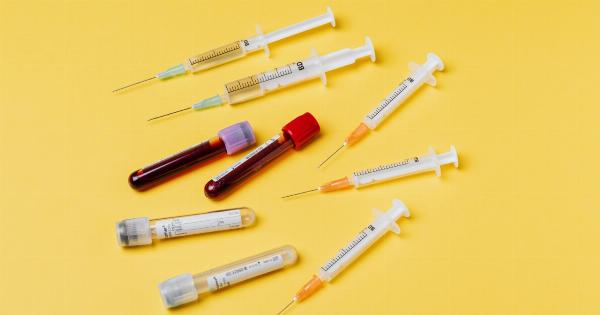Mediterranean anemia, also known as Thalassemia, is a type of blood disorder characterized by an abnormal production of hemoglobin, leading to a severe anemia.
This disorder is genetic and is most prevalent in populations originating from the Mediterranean region, such as Greeks, Italians, and Middle Easterners. It is estimated that about 300,000 newborns are affected by this disorder globally each year (1).
Understanding the inheritance and treatment options for Mediterranean anemia is important for managing the disease and improving patients’ quality of life.
Inheritance of Mediterranean Anemia
Mediterranean anemia is an autosomal recessive genetic disorder caused by mutations in genes that control the production of hemoglobin. Hemoglobin is the protein found in red blood cells which transports oxygen to the body’s tissues.
There are two types of proteins that make up hemoglobin – alpha-globin and beta-globin. The genes that control the production of alpha-globin are located on chromosome 16, while the genes that control the production of beta-globin are located on chromosome 11.
A person must inherit two copies of the mutated gene – one from each parent – to develop the condition.
If a person inherits only one mutated gene, they are said to be carriers of the disease and do not have any symptoms, however, they can still pass the mutated gene to their children.
The inheritance of Mediterranean anemia can be explained by using a Punnett Square.
If two carriers of the disease have a child, there is a 25% chance that the child will inherit two normal genes and will not have the condition, a 50% chance that the child will inherit one normal gene and one mutated gene and will become a carrier of the disease, and a 25% chance that the child will inherit two mutated genes and will develop the disease (2).
Symptoms of Mediterranean Anemia
The severity of Mediterranean anemia varies depending on the number of abnormal hemoglobin genes a person inherits.
Individuals with one abnormal gene may have no symptoms or only a mild anemia, while those with two abnormal genes can have severe anemia and numerous other symptoms.
Common symptoms of Mediterranean anemia include:.
- Fatigue and weakness
- Pale skin
- Jaundice
- Shortness of breath
- Dizziness or lightheadedness
- Delayed growth and development in children
People with severe Mediterranean anemia may also experience bone deformities, especially in the face and skull, which can cause health problems over time. The spleen may become enlarged, and there is an increased risk of infections.
Diagnosis of Mediterranean Anemia
A diagnosis of Mediterranean anemia begins with a physical examination and medical history, followed by blood tests to determine hemoglobin levels and the number of red blood cells in the body.
If the results indicate anemia, additional tests may be conducted to confirm the diagnosis and determine the severity of the condition. These tests may include:.
- Hemoglobin electrophoresis to detect abnormal hemoglobin levels
- DNA analysis to identify specific gene mutations
- Bone marrow examination to assess the production of red blood cells
Treatment Options for Mediterranean Anemia
There is currently no cure for Mediterranean anemia, but several treatment options are available to manage the condition and improve quality of life.
Treatment options may vary depending on the severity of the anemia and the patient’s overall health status.
Blood Transfusions
Blood transfusions involve the transfer of healthy red blood cells to replace the abnormal cells produced by the body. This treatment is usually reserved for patients with severe anemia who require immediate relief of symptoms.
However, frequent transfusions can result in an iron overload in the body, which can cause additional health problems over time.
Iron Chelation Therapy
Iron chelation therapy is used to remove excess iron from the body that accumulates due to frequent blood transfusions.
This therapy involves the administration of medication, such as deferoxamine or deferasirox, which bind to excess iron in the bloodstream and eliminate it from the body.
Bone Marrow Transplant
A bone marrow transplant involves the transfer of healthy bone marrow stem cells from a donor to replace the abnormal cells in the patient’s bone marrow.
This treatment is only recommended for patients with severe anemia and a suitable donor, as it carries significant risks and requires careful medical supervision.
Preventing Mediterranean Anemia
As Mediterranean anemia is a genetic disorder, it cannot be prevented entirely. However, there are measures that carriers of the disease can take to reduce the risk of passing the mutation to their children.
Carrier testing can be conducted before conception to determine the risk of transmitting the disease to offspring. If both parents are carriers of the mutation, they may choose to undergo IVF with pre-implantation genetic diagnosis (PGD) to select embryos free from the mutated gene for implantation.
Conclusion
Mediterranean anemia is a genetic blood disorder that causes severe anemia and other health problems. Understanding the inheritance and treatment options for the disease is important for managing the condition and improving quality of life.
Blood transfusions, iron chelation therapy, and bone marrow transplant are the common treatment options available. Effective prevention measures such as carrier testing and IVF with PGD can help to reduce the risk of passing the mutation to offspring.






























